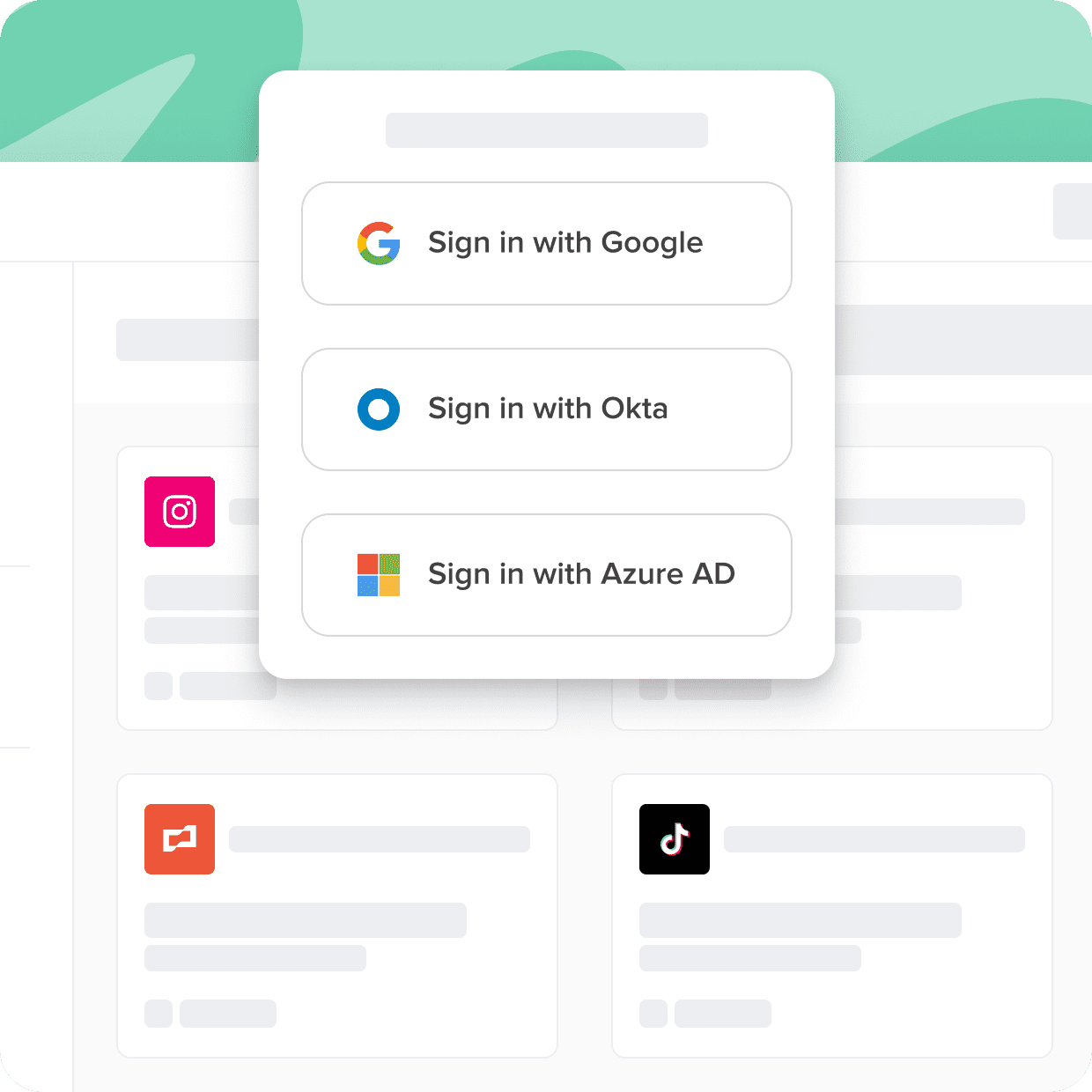Single sign-on (SSO) integration is the process of implementing SSO functionality into a software application or system. SSO is a fantastic technology that allows businesses to eliminate password reuse and simplifies the login process.
Unfortunately, many corporate applications don't support the SSO standard and can't reap all the benefits. The applications that fall into this category are best called "nonfederated." Nonfederated applications are a new category that is becoming increasingly challenging for businesses to manage and secure effectively, yet increasingly critical for businesses to succeed.
Cerby connects all of your apps to your SSO tools, even if they don't support the SSO standard. In this guide, you'll learn about SSO software, the history, and the benefits.
Streamline Access With Single Sign-On
Not all apps are created equal. Some come with security gaps and complexities that can hinder user adoption and put sensitive data at risk. With Cerby, you can ensure secure and seamless access to all your applications, regardless of their support for standards like SSO.
With Cerby You Can

Close the identity gap

Universally enforce 2FA

Eliminate the SSO tax
Single Sign-On Integration
As workplaces become more digitized and as employees continue to navigate multiple digital applications and platforms in order to perform job duties, the importance of effective security measures becomes ever more prevalent. To address these challenges and others, companies are increasingly turning to SSO (single sign-on) integration, a solution that allows users to authenticate once to gain access to multiple applications seamlessly.
SSO integration refers to a mechanism that enables users to log in only one time and access multiple unique applications and/or systems without having to log in again or enter new credentials. Generally speaking, SSO simplifies the user experience, helps improve productivity, and enhances security by eliminating the need to manage multiple usernames and passwords.
By implementing single sign-on infrastructures, companies can streamline access to various tools and resources, from internal systems like project management platforms and intranets to external services like customer relationship management software or other cloud-based storage solutions.
To successfully integrate SSO into their tech stack, organizations can leverage dedicated SSO services or rely on identity and access management platforms that also offer SSO features. In most cases, SSO services will provide pre-built connections and APIs that enable seamless integration with common business applications, which simplifies the implementation process. Additionally, IAM platforms frequently offer more advanced features like centralized user management, multi-factor authentication, and audit logs, which can further improve an organization’s security posture.
SSO integration poses a number of benefits for companies of all sizes, including improved user experience, enhanced security measures, and increased productivity. Integration also helps pave the way toward a more efficient and secure digital environment, enabling teams to focus on their core tasks, like driving business success.
How Does Single Sign-On Work
Single sign-on essentially eliminates the need for users to remember and enter separate usernames and passwords for each individual application, greatly streamlining the authentication process.
To illustrate how SSO works, consider a typical single sign-on example within an enterprise. Perhaps there’s an employee who needs to access various applications like email, project management software, and document collaboration tools. In a traditional setting, John would have to remember and enter three different login credentials for each application. But with single sign-on authentication, the employee can log in only once and gain access to the other authorized applications without having to enter additional credentials.
So, how does single sign-on work in practice? When an organization implements SSO, it usually involves the following steps:
- Identity provider (IdP) – The IdP acts as the core component of SSO infrastructure; it stores and manages user identities and authentication information. The IdP also acts as a trusted authority that can verify user credentials and issue tokens to grant access to certain applications.
- Service providers – The service providers represent the applications or service users who want to access and rely on the IdP to authenticate users and authorize access.
- SSO tools – These provide the necessary functionality to facilitate the entire SSO process, and SSO tools may include software or services that enable the integration between the IdP and service providers, manage user authentication, and handle the exchange of authentication tokens.
SSO enables users to access multiple applications with only a single set of credentials. In an enterprise setting, the SSO process involves an IdP, service providers, and capable SSO tools. When implementing SSO infrastructure, organizations can greatly enhance user convenience, improve employee productivity, and strengthen security measures by centralizing user authentication and reducing the risk of weak or reused passwords for multiple applications.
Single Sign-On Methods
Single sign-on methods offer myriad approaches to streamlining authentication across multiple applications, improving user experience, and reducing login friction. In this section, we will explore a handful of unique SSO methods and their use cases, including a single sign-on example (Java), various single sign-on protocols, and the effectiveness of an SSO portal.
One of the most popular single sign-on methods is using SSO protocols such as Security Assertion Markup Language (SAML) and OpenID Connect (OIDC). SAML is an XML-based protocol that enables the secure exchange of authentication and authorization data. This method is especially common in enterprise environments where SSO integration with legacy applications is required.
Another common SSO method is based on OAuth 2.0, which is frequently utilized within delegated authorization scenarios. OAuth 2.0 enables users to grant limited access to their resources from one website to another without sharing credentials. For example, a mobile app that needs access to a user’s Google Drive files may utilize OAuth 2.0 to request authorization on behalf of the user, leveraging their Google Sign-In credentials to facilitate the authentication.
Additionally, some organizations may utilize an SSO portal, also known as an IdP portal, to centralize the authentication process. An SSO portal acts as a kind of gateway for users to access various applications and services within an organization’s network. Users log in once to the portal and subsequently gain access to multiple applications. This method provides a unified authentication experience and significantly simplifies user management for IT administrators. For instance, a business could implement an SSO portal to provide employees with a single sign-on login access to their email, project management software, HR systems, and other internal tools.
Single Sign-On Solutions
When selecting a single sign-on solution for your company or team, there are several factors to consider carefully. These factors may include evaluating an SSO service provider that aligns with your business objectives, understanding the single sign-on login options, and exploring popular single sign-on solutions like Azure AD SSO SAML and Okta. Regardless of your decision, SSO solutions have become integral components for companies seeking to enhance their security posture and improve user experience.
Azure AD SSO SAML and Okta are some of the most popular single sign-on solutions, and both are worth considering for a number of reasons. Azure AD SSO SAML leverages SAML protocols to enable secure authentication and authorization between identity providers and service providers. It also provides seamless integration with Microsoft Azure and is well-suited for organizations that heavily utilize Microsoft services.
Okta, on the other hand, is a comprehensive identity and access management platform that offers powerful single sign-on capabilities and functionality. It supports numerous protocols, including SAMl, OAuth, and OpenID Connect, which makes it highly adaptable to various application ecosystems. Single sign-on Okta provides a centralized identity and access management hub, meaning organizations can more easily manage user identities, access policies, and authentication factors.
Single Sign-On Providers
When it comes to implementing single sign-on solutions for companies, SSO providers can play a crucial role by enabling seamless authentication experiences across multiple applications. Single sign-on providers also offer specialized services and tools to simplify the integration process and bolster security.
When considering SSO solutions for your organization, it’s essential to get a better understanding of all the different single sign-on providers, including the most popular SSO providers, as well as the advantages of using an SSO identity provider and the availability of an SSO provider (open-source).
Typically, SSO providers offer dedicated services and/or platforms specifically engineered to facilitate the implementation of SSO solutions. They offer comprehensive features and functionality to help streamline user authentication and access management across numerous applications. In order to make the most of their expertise, organizations can save lots of time and resources by building and maintaining their own SSO infrastructures.
Additionally, an SSO identity provider serves as the centralized authority for user authentication, managing user identities, and basic credentials. It authenticates users and generates secure tokens for accessing certain applications. Utilizing an SSO identity provider substantially improves security because authentication processes are consolidated, and the risk of using weak or compromised passwords across multiple applications is virtually eliminated.
Single Sign-On Architecture
From a technical perspective, single sign-on architecture works by leveraging authentication protocols and tokens to establish trust between IdPs and service providers – this is how SSO works.
In most SSO architecture settings, a user will attempt to access an application or service. Instead of entering their usual credentials into the application, the user is redirected to an identity provider’s login page. There, the user may provide their login credentials which are verified by the identity provider.
Once authenticated, the identity provider generates a secure token, commonly known as an SSO token. This token contains important information about the user’s identity, authentication status, and access permissions, and the token is digitally “signed” by the identity provider to ensure its validity and integrity.
However, during the Ponemon Institute’s research, a majority of respondents said their organization experienced a cybersecurity incident due to the inability to secure nonfederated applications. This results in the loss of customers and business partners.
Overall, SSO authentication methods provide a seamless, efficient way for users to access multiple applications with a single sign-on login. By leveraging single sign-on protocols and SSO tokens, organizations can seriously enhance user experience, reduce password fatigue, and improve general security measures. SSO architecture simplifies the entire authentication process, making it much easier for both technical professionals and employees to focus on their actual job duties.

